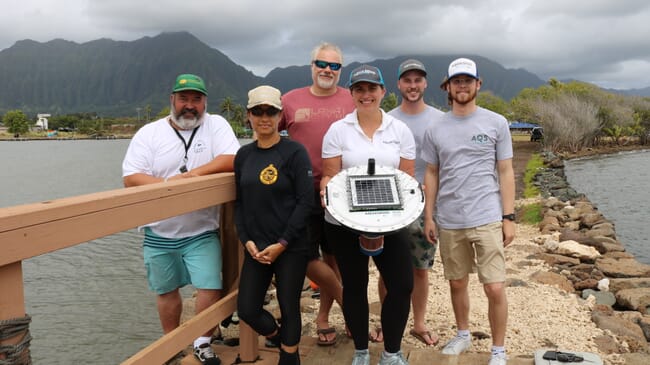
The Aquasend Beacon will continuously monitor the pond’s dissolved oxygen (DO) and temperature levels throughout the day to assess the pond’s fish density © Aquasend
Aquaculture sensor startup Aquasend recently deployed three Aquasend Beacons in the Hawaiian fishpond, Waikalua Loko l’a, through its partnership in the Xylem Innovation Labs’ Incubator Programme. The Pacific American Foundation who is overseeing the project, is utilising the beacon’s data to assist with the restocking of native mullet and milkfish.
Prior to Hawaii’s statehood, there were nearly 500 fishponds across the Hawaiian Islands. As time has passed the number of fishponds has decreased to less than 100. Efforts to preserve the remaining Hawaiian fishponds are increasing with the help of The Pacific American Foundation. They are focused on rehabilitating and learning Waikalua Loko l’a carrying capacity. To assist in the effort, the Aquasend Beacons will monitor the amount of biomass the pond is equipped to support through dissolved oxygen (DO) levels and temperature data collected.
Located in Oahu, Hawaii, the Waikalua Loko l’a fishpond was constructed more than 400 years ago by early Hawaiians after meticulously studying the water and tides. The fisherman realised creating water barriers would lead to more consistent and abundant fish harvests.

The fishpond was constructed more than 400 years ago by early Hawaiians © Aquasend
Waikalua Loko l’a operates with stationary gates called makahas, which are located in the canal and built into the seaward wall of the pond. Maintaining the original design created by Hawaiian ancestors, the gates are designed with small vertical standing wood poles held together with rope to let smaller fish into the pond. The fish would be fed, grow and become trapped in the fishpond due to their larger size.
The pond is made from a combination of salt and fresh water, Waikalua Loko l’a brackish water consists of North Pacific saltwater from a bay that actively circulates the pond while surrounding freshwater streams, Kawa and Kane`ohe, percolate the soil to enter the pond.
The Aquasend Beacon will continuously monitor the pond’s dissolved oxygen (DO) and temperature levels throughout the day to assess the pond’s fish density. More than 50 years have passed since the Waikalua Loko l’a pond habituated aquatic life, so it is essential the pond’s water is heavily monitored and brought to safe levels for successful pond restoration.
“We are thrilled to be part of the Waikalua Loko l’a pond regrowth and have the opportunity to expand Aquasend water technology operations through our partnership in Xylem’s Incubator Programme. It’s our goal to support this industry with data and solutions,” Kristin Elliott, CEO of Aquasend says.
Advanced water quality technology is needed to determine the viability of the pond. Three Aquasend Beacons were deployed and installed across the pond’s brackish water to gather data on both moving and stagnant water points. The buoys are collecting real-time dissolved oxygen and temperature measurements continuously throughout each day over a period of three months.
Data collected over these months will provide the Pacific American Foundation with fundamental information required to start safely inhabiting the pond with native mullet and milkfish. The Beacon’s research will provide a better understanding of Waikalua Loko l’a conditions and will ultimately help enable the growth of Waikalua Loko l’a and other ponds across the Hawaiian Islands to generate income and sell products locally.




